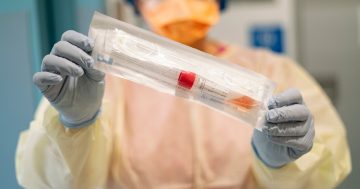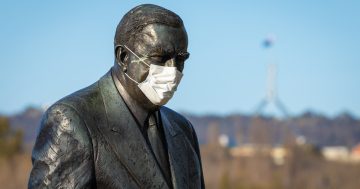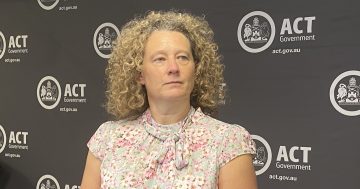
Chief Minister Andrew Barr at the AIS Arena Mass Vaccination Clinic, which will now accept walk-ups. Photo: Ian Bushnell.
UPDATED 3 pm: The ACT is tracking to have more than 90 per cent of its eligible population aged over 12 receive their second COVID-19 vaccine by the end of October, making it one of the most vaccinated places in the world.
Chief Minister Andrew Barr said that the ACT would soon reach 99 per cent for first doses and that the second dose figure should match this by early November.
Driving this vaccination push over coming weeks will be changes to make the vaccines more accessible, including walk-up appointments at the AIS Arena Mass Vaccination Clinic and pop-up testing in selected postcodes to reach people in vulnerable settings who may not be able to travel.
Immuno-compromised people will also be able to get a third dose of Pfizer vaccine from their GP.
Mr Barr said vaccination was now doing the heavy lifting, and the Test, Trace, Isolate and Quarantine (TTIQ) effort would begin to phase down, and those settings would be updated this week.
“This is just so critical to our economic recovery, to protect our health system and to ensure that Canberrans can emerge from lockdown and the gentle steps that we take over the coming two to four weeks to get back into a more normal life,” he said.
Tomorrow, the ACT Government will provide details of the next step in its Pathway to be implemented on Friday.
On Wednesday and Thursday, it should be able to update cross-border travel rules in coordination with the NSW Government.
But Mr Barr said the current rules would not change dramatically on Friday.
He said the number of postcodes within the Canberra region with exemptions would increase and they would remain the arrangements for the last two weeks of October.
“Beyond the point NSW reaches 80 per cent double dose, they’ve indicated changes, for example, to allow Greater Sydney [residents] to travel into the regions. That will be a trigger point at which the ACT residents would be allowed to travel further into the regions.”
But Mr Barr warned that NSW had said any Canberran caught in Queanbeyan over the next few days would face heavy fines and no one from across the border should come into the ACT for non-essential reasons.
“Today is not an opportunity for ACT residents to cross into NSW for non-essential reasons,” he said.
“Travel will change on Friday, and change again at the end of October and then, in December when NSW drop their vaccinated and unvaccinated status, travel will free up significantly.”
While the number of cases was becoming less important, Mr Barr said the government still wanted to keep them as low as possible.
“The disease is going to become endemic in our community,” he said.
“There will be hundreds and hundreds of cases, but the vaccines will prevent serious illness, and you’ve just got to see what’s happening in NSW and Victoria to know that there aren’t any people in intensive care who are fully vaccinated, there aren’t many people even in hospital who are fully vaccinated,” he said.
“But you can have a breakthrough infection where fully vaccinated people can still get the virus, and carry it with them for days and days, and transmit to others, and they may not even know they’ve got the virus.”
There would still be a need for public health measures and TTIQ arrangements as vaccination rates rise.
“That’s why we’re not having freedom day today. That’s why it will be a gentle step forward on Friday and then another one two weeks after that,” he said.
Mr Barr said the ACT’s vaccination performance showed that Australia should have been much more ambitious with its program.
“I have always viewed 80 per cent as a floor not a ceiling, and I think we have demonstrated that it should always have been a floor,” he said.
Mr Barr said no one had modelled rates of 90 to 95 per cent, and when the ACT argued for more vaccines, the Federal Government did not think it could be done.
“This is a significant achievement,” he said.






















